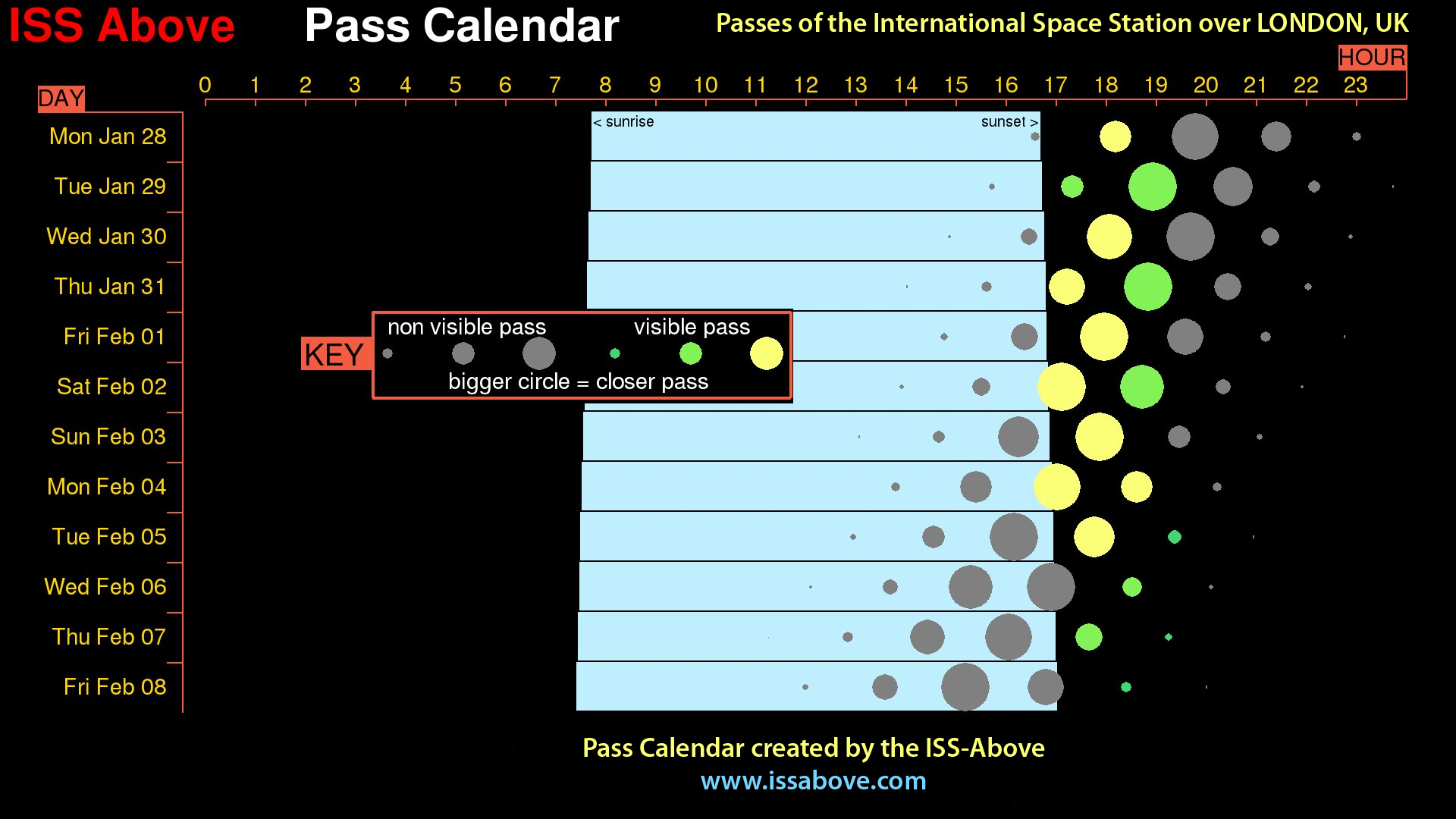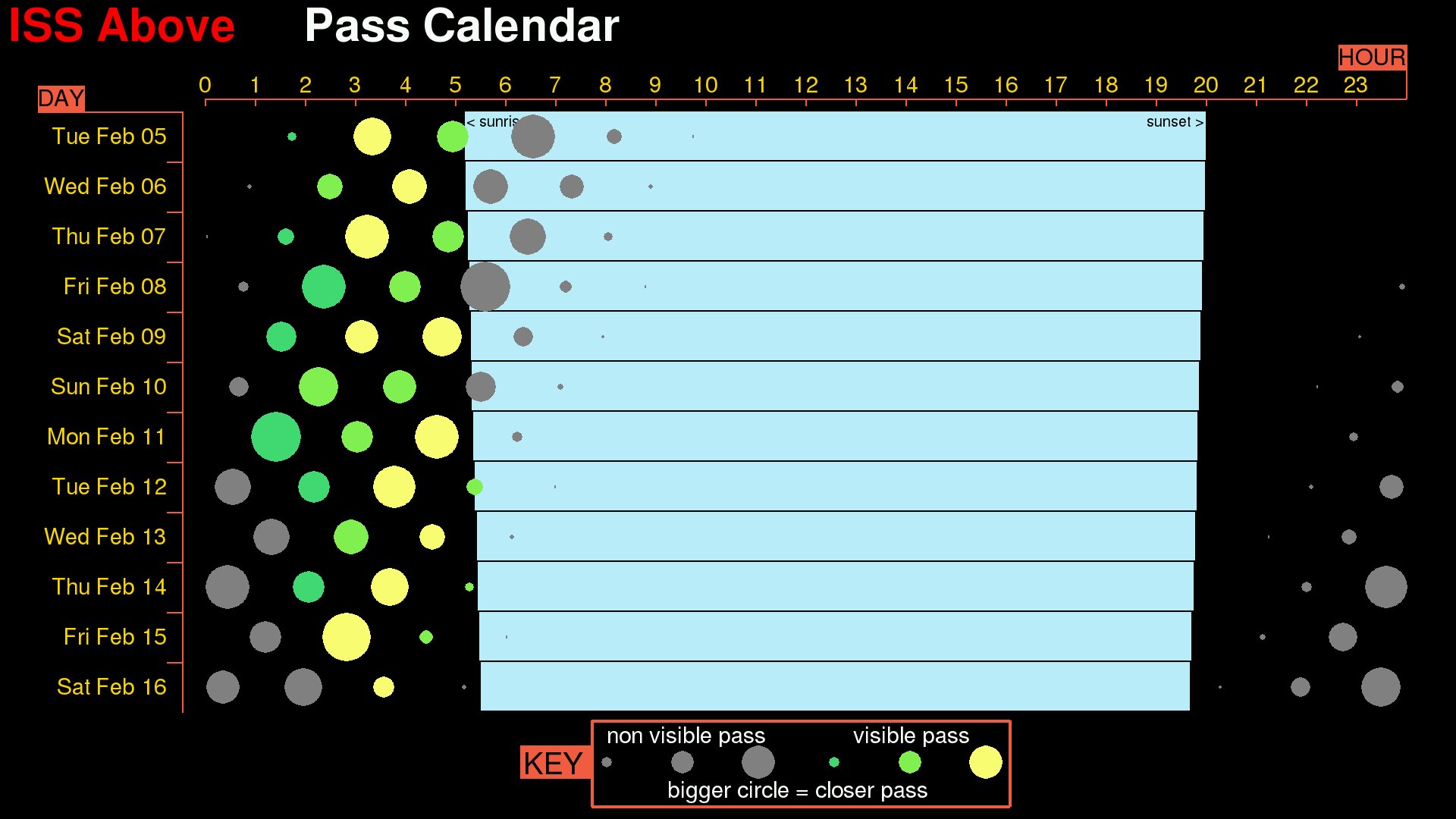New Feature: ISS Pass Calendar
/Having been immersed in this whole world of keeping track of ISS passes for the past 5 years (since 2013 actually) there are times when I really want to know if the ISS is going to be making passes over a particular location both during the day-time and also to find out when those groups of visible passes are going to happen.
I have built a new capability to help show this information in a unique way. It’s called the ISS Pass Calendar and this is what it looks like
ISS Pass Calendar
It looks like a lot is going on - but it’s really very simple.
It shows the passes of the ISS over your location for a period of about two weeks. For each day it shows when each pass is happening by putting a circle centered right over the time of the pass.
The Key describes what the size/color of the circles mean
You’ll see the grey colored circles mean a non-visible pass and the green or yellow means a visible pass. The size of the circle lets you know how close the pass will be to you. The biggest circles mean the ISS will be passing almost directly over your heads.
Have you ever noticed the ISS has groupings of visible passes at certain times of the month? This pass calendar shows that phenomena very well.
How do you see YOUR Pass Calendar?
The easiest way to get your device to display this on your TV is to press the “9” key on your MX3 Airmouse remote (see this post about that). pro tip: you can also use any USB keyboard plugged in to one of the ISS-Above’s USB ports to do the same thing.
Or using your ISS-Above web admin go to the /control page and click on the Pass Calendar button at the bottom of that page.
For now I do not intend to have this information be displayed automatically (like other information screens) as I consider it a little too “technical”. However that doesn’t mean I don’t think this information is REALLY cool to know.
I personally look at this calendar quite frequently. It really helps me know if the ISS is going to be making some great DAY TIME passes.
Why is that important you might ask? Good question!
As far as I am concerned one of the greatest features of the ISS-Above is for it to show live video from the ISS when it’s passing YOU by in the daytime.
The pass calendar will show you exactly when that’s going to be happening in the future. That’s particularly useful to know if I’m going to be at a conference or giving a presentation at a school or other event. it’s always extra special when I can show conference attendees live video of THEM during the day.
I will be making further updates to allow you to get a Pass Calendar created for any time in the future - not just from the current day out for two weeks. I’ll update this blog post when I have done that.
Getting a little more scientific about this.
You can see from the example calendar above it very nicely shows the groupings of visible passes - both in the morning and the evening. That example is for Johnson Space Center.
I was curious to see if the visible passes “looked” different for different latitudes. I had noticed for instance it appeared the UK (at ~ 52 degrees latitude) just seemed to get far more visible passes than me (33 degrees latitude). It turns out the number of visible passes is truly impacted by your latitude. Check out these pass calendars for different locations around the earth.



You may ask “Why is there such a difference”? It’s no doubt related to the specific orbital dynamics for the ISS which has an inclination of 51.6 degrees from the equator (the angle the orbit makes). Beyond THAT I don’t have a better explanation as to the why.
Then on another (slightly scientific) matter. Do you notice how there appears to be a truly mathematical sequence of passes from day to day?
Now of course Orbit = Math - it’s just the way all this stuff works.
Nevertheless that sequence of passes when you view it across many days I just find it SO mesmerizing.
Look how the size of the circle changes (grows or shrinks) based upon one day minus ONE orbit (92 minutes) every single day.
That’s what is responsible for the shifting times of the passes and how they shift from day to day / week to week. I just find all of that so fascinating - and seeing the passes displayed like this really allows me to see the patterns of these passes in a way I have not previously been able to comprehend or appreciate.
There ends the technical part of this blog post.
I hope you like the new feature



